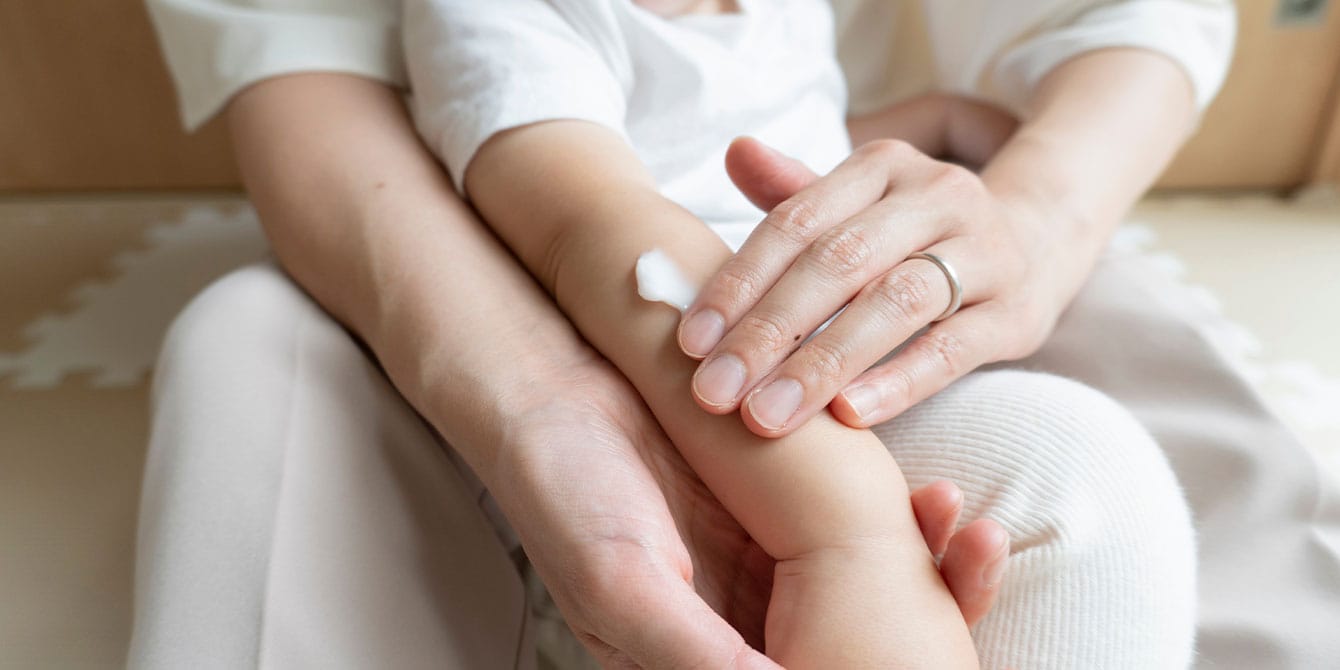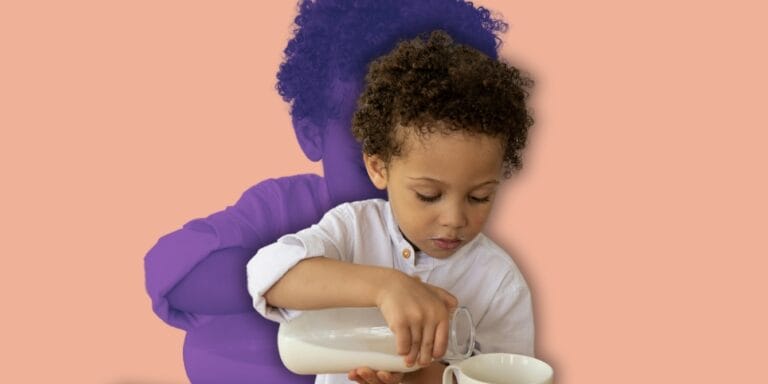How to treat your child’s eczema

leeeee77/Shutterstock
Eczema can be worrisome. The good news? Treatment is available.
We independently select and share the products we love—and may receive a commission if you choose to buy.
Table of Contents
It’s known as the “itch that rashes”—and many moms know it as a cause of crankiness, pain and loss of sleep among their little ones. It’s eczema, one of the most common skin conditions in children, afflicting up to 30% of children (and up to 10% of adults), and presents with dry, scaly red skin, a rash, and, of course, the uncomfortable, fussiness-inducing itch.
While it can be worrisome when you see eczema crop up on your child’s skin, the good news is that treatment is available, including a promising new medication. Here’s a look at various ways to offer your little one some much-needed relief from eczema.
A new drug may help treat eczema in kids
Promising news for kids with eczema: dupilumab, a biologic drug that has been proven to be safe and effective in treating the condition in adults, is now offered to pediatric patients, as well. According to the findings of a recent study by the Northwestern University Feinberg School of Medicine, dupilumab reduced the severity and provided relief from symptoms of moderate-to-severe eczema in infants and children aged six months to five years old.
The medication, available to children as young as six months, works by blocking the action of the critical substances (interleukins) involved in the progression of eczema. In the Northwestern study, 66% of the children who had developed eczema in the first six months of life responded to dupilumab, with a 75% reduction in eczema symptoms, particularly itching and sleepless nights. It also reduced the risk of developing other conditions associated with eczemas, like asthma and food allergies.
“The ability to take this drug will significantly improve the quality of life for infants and young children who suffer tremendously with this disease,” says lead study author Dr. Amy Paller, chair of dermatology at Northwestern University Feinberg School of Medicine, in an article published by Science Daily. “By treating more aggressively to calm the immune system activation in these young children with early, severe eczema, we may also reduce the risk of their developing a range of allergic problems, changing their life beyond improving eczema.”
Other eczema treatments for kids
Of course, there are other methods to treat your child’s eczema. From moisturizing to topical ointments, here’s a look at how you can help reduce the rash.
Moisturize often
Because eczema occurs due to damage to the skin barrier, often resulting in dry skin, cutaneous hydration—AKA moisturizing—can relieve the rash. A safe-for-babies treatment applied directly on your child’s skin will work to provide an extra layer of protection, which can reduce irritation.
“Keeping skin well-hydrated and moisturized is very important for people with eczema, as this helps to keep the outer layer of skin functioning properly,” says Alpana Mohta, MD, certified dermatologist and medical advisor for BetterGoods.org. “Applying a moisturizer after bathing and throughout the day can help keep eczema symptoms under control.”
Related: How to treat eczema in kids, according to a dermatologist
Topical corticosteroids
Topical corticosteroids, or steroid creams, ointments, and solutions, are another effective treatment for eczema in children, says Dr. Mohta. Examples include triamcinolone acetonide cream (Kenalog), hydrocortisone cream (Cortizone-10) and desonide ointment (Desowen). As with all medications, it’s important to consult a doctor before using any steroid cream, especially as some formulations may not be approved for use in young babies and toddlers.
Dr. Mohta stresses that because regular use of these medications can cause side effects like skin thinning, it’s key to use them only as directed and for the shortest amount of time needed to treat eczema. You may be advised to use an emollient first, and then wait for about 30 minutes before applying the recommended amount of corticosteroids on the affected skin.
Antihistamines
Antihistamines, which work to block the release of histamine in the body, a substance that makes skin more sensitive and prone to allergic reactions, can be helpful for some people with eczema.
“However, it’s important to consult a doctor before taking any medication, as some antihistamines can cause side effects,” says Dr. Mohta.
Related: How to spot baby eczema
Eczema treatment to reduce itching
However you opt to treat eczema, there’s also the issue of itching. During an eczema flare-up, the itch can be unbearable, but experts warn that scratching or picking only causes more irritation. What to do? To start, break out the cold compress, says Dr. Mohta.
“Cooling compresses may help calm the skin and provide relief from itching,” she notes.
Also look for topical creams that contain hydrocortisone or other ingredients such as coal tar or vitamin D, and make sure to keep the skin moisturized. And if the itch continues to be unbearable? Talk to your pediatrician about medications that may help.
The do’s and don’ts of treating eczema in kids
Your child’s skin is super-sensitive. Here are 10 do’s and don’ts of treating eczema for your kids:
- Don’t dress them in wool or nylon clothes and perfumed fabric, which can cause further skin irritation.
- Do dress them in cotton clothes. Do give your kid short (think: 5 to 10 minutes) baths in luke-warm water to hydrate, cleansing the skin with a mild soap.
- Don’t scrub the skin; instead, pat gently. Do apply a moisturizer three minutes after the bath.
- Don’t leave any blisters or affected areas uncovered. Instead, use a wet gauze covering, which is also helpful in preventing scratching.
- Do maintain a pleasant temperature and humidity level in your room—experts recommend about 64°F (18°C). Lack of proper air ventilation in your home can trigger eczema flare-ups.
- Don’t give your child medication or do anything extreme (like a bleach bath, which may help in children with moderate to severe eczema) without consulting your doctor first.
- Do inquire with your doctor about food sensitivities or allergies, which are linked to eczema. You may want to keep a food diary to record any unusual signs and symptoms that follow after meals.
- Don’t leave any sign of infection (redness, swelling, or oozing from the skin) untreated. See a doctor immediately.
Featured expert
Alpana Mohta, MD, certified dermatologist and medical advisor for BetterGoods.org.
Sources
Lee JH, Son SW, Cho SH. A Comprehensive Review of the Treatment of Atopic Eczema. Allergy Asthma Immunol Res. 2016;8(3):181-190.
Nemeth V, Evans J. Eczema. StatPearls Publishing. 2022.
Paller AS, Simpson EL, Siegfried EC, Cork MJ, Wollenberg A, Arkwright PD, Soong W, Gonzalez ME, Schneider LC, Sidbury R, Lockshin B. Dupilumab in children aged 6 months to younger than 6 years with uncontrolled atopic dermatitis: a randomised, double-blind, placebo-controlled, phase 3 trial. The Lancet. 2022 Sep 17;400(10356):908-19.






































